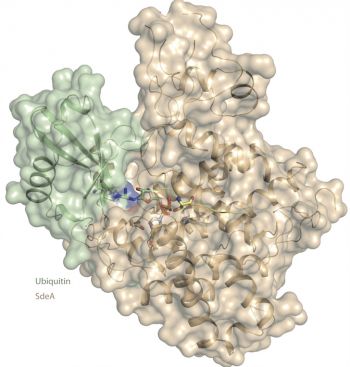23 May 2018 - Complementing conventional antibiotics: Frankfurt scientists reveal atomic details for one of Legionella’s enzymatic weapons and develop first inhibitor.
Antimicrobial resistance (AMR) is a major medical problem worldwide, impacting both human health and economic well-being. Scientific efforts are underway to achieve better control of infections.
One promising approach is to limit damage to host cells and tissues in the course of a bacterial infection by blocking the microbial processes that cause such damage. In today’s online issue of Nature, the laboratory of IBC2 Director Ivan Dikic reports a breakthrough substantiating the feasibility of this novel strategy.
The scientists solved the structure of the catalytic core of Legionella toxin SdeA. Sissy Kalayil, who is one of the lead scientists on the project, comments: “We reveal atomic details of this mechanism, which now make the rational design of inhibitors possible.”
Legionella are known to cause pneumonia and are especially dangerous for immunocompromised patients. The team also showed how this bacterial effector probably chooses its victim proteins within the host cell, exerting its effect by attaching ubiquitin to them. They also developed a first inhibitor blocking the reaction in vitro.
“Our basic discovery has allowed us to prove that these enzymes are druggable,” Dikic comments. “But it is early days. There is a long road ahead of us before we will be able to use this novel mechanism therapeutically. And we will surely not stop here.”
